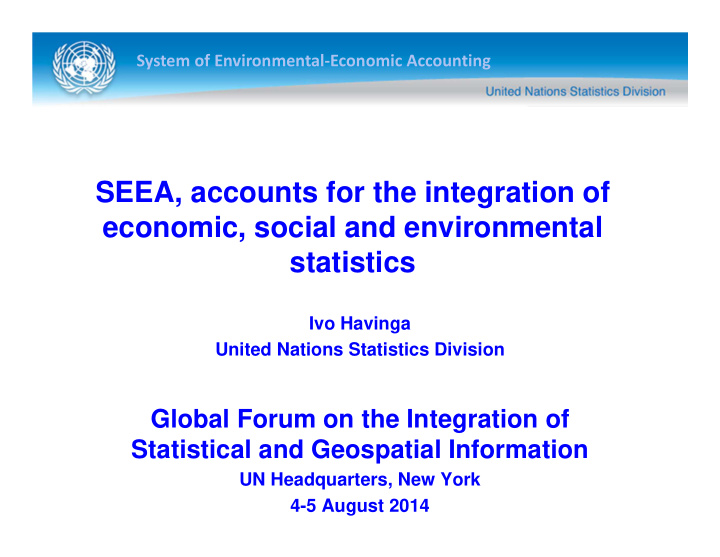



System of Environmental ‐ Economic Accounting SEEA, accounts for the integration of economic, social and environmental statistics Ivo Havinga United Nations Statistics Division Global Forum on the Integration of Statistical and Geospatial Information UN Headquarters, New York 4-5 August 2014
System of Environmental ‐ Economic Accounting Overview SEEA EEA as integration framework SEEA-EEA explicitly recognizes and incorporates the geographic perspective • Ecosystems are spatially explicit units….. Ecosystem accounting: data inputs and spatial accounting units Integration and harmonization of wide-range data Examples from land and carbon accounts
System of Environmental ‐ Economic Accounting SEEA-EEA integration framework Integration of ecosystem services in macroeconomic aggregates, like GDP and NDP Amenity Risks Ecosystem services in monetary and physical terms Land account Consistent physical and monetary asset accounts Land cover/use Accounting units Raw data collection, processing Administrative reg., and harmonization habitats, ecoregions
System of Environmental ‐ Economic Accounting Spatial data perspective: harmonizing data inputs Use of existing spatial measurement methods and existing data Development of new spatial data processing methods based on ‘Assimilation cubes’ Upscaling Downscaling e.g. 1k x 1k Data inputs from multiple sources are linked and stored in an integrated database based on a grid structure
System of Environmental ‐ Economic Accounting Assimilation Cube to integrate grid information Work on this concept/idea? Challenge is • Multidimensional space – grid and cube • Different characteristics can read across • Privacy issue - ▫ Privacy (statistical discipline) versus information for decision making (policy) Benefits • Building blocks from different disciplines ▫ In many instances measuring the same thing but with a different discipline underlying the motivation
System of Environmental ‐ Economic Accounting Geography Accounting Building analytical capability e.g. unified and for units and ensure that GIS hierarchical classifications standards are maintained and variables for units (grid)
System of Environmental ‐ Economic Accounting Hierarchical (nested-grid) aggregation Country State Ecosystem Accounting Unit (EAU) Region Statistical Areas Land Cover/Ecosystem Functional Unit Parcel (LCEU) Grid cell Basic Spatial Unit (e.g. 20m x 20m or 100m x 100m) (BSU) 7
System of Environmental ‐ Economic Accounting Spatial data perspective: harmonizing reporting units Measurement units for social, economic and environmental parameters remain untouched New accounting and reporting units created for ecosystem accounting purposes Overlay of units (UK )
System of Environmental ‐ Economic Accounting Spatial data perspective: reporting and mapping • Pivot tables are used to query, extract and map the accounts in GIS
System of Environmental ‐ Economic Accounting SEEA-EEA developing an international standard From national accounting perspective: assessment through the measurement of ecosystems and their flows of services into economic and human activity From business perspective accounting: tools are developed to assist sustainable management of crops, timber, fisheries (sectoral approaches) in an ecosystem perspective: • A number of initiates: e.g. Global forest watch (http://www.globalforestwatch.org/) Explore certified concession areas for palm-oil production Harmonizing indicators from business and national accounting perspective is an aspiration
System of Environmental ‐ Economic Accounting Examples: Harmonization issues of Land cover maps
System of Environmental ‐ Economic Accounting Examples: Carbon accounting illustrates an integrated application of spatial and statistical data GPP Statistical data on: TER 1. Forest biomass (FRA, 2000, 2005, 2010) 2. Crops harvest (EUROSTAT 2000 – 2010) 3. Timber harvest (EUROSTAT 2000 – 2010) 4. Livestock (EUROSTAT 2000 – 2010) Exports Imports Remote sensing products: 1. CORINE Land cover (2000, 2006) 2. SPOT vegetation NDVI (1999 – 2010) 3. Primary production (GPP) and Ecosystem respiration (TER) (NASA, 2000 – 2010)
System of Environmental ‐ Economic Accounting Examples: European carbon accounts The two basic balancing items are designed to summarize ‘vertical’ and ‘horizontal’ carbon transfers Balance of lateral imports and exports Net ecosystem production = Gross Primary = Carbon returns – carbon ‘uses’ Production – Terrestrial Ecosystem Respiration
System of Environmental ‐ Economic Accounting Examples: Net ecosystem carbon balance • On country level the ecosystem carbon accounts should be consistent with IPCC’s in assessing whether ecosystems acted as net source or sink of CO2 for a given period of time. • The maps shows a decade average, with areas in green indicating prevailing sink (most of Europe) and in red – prevailing source functions (e.g. parts of North West Europe, Po valley in Italy, and spots of forest-burned areas of Portugal).
System of Environmental ‐ Economic Accounting Conclusions SEEA EEA steers strategic directions articulating new priorities in both geography and statistical domains of work. • It can bring ‘win-win’ joint projects For accounting: • new geospatial technologies enable the experimentation of integrated ecosystem accounts in widely comparable / international space, thus contributes to standardization For geography / GIS: • the framework provides opportunities for added value applications – e.g. spatially explicit accounts supporting evidence-based (better informed) decision-making
Recommend
More recommend